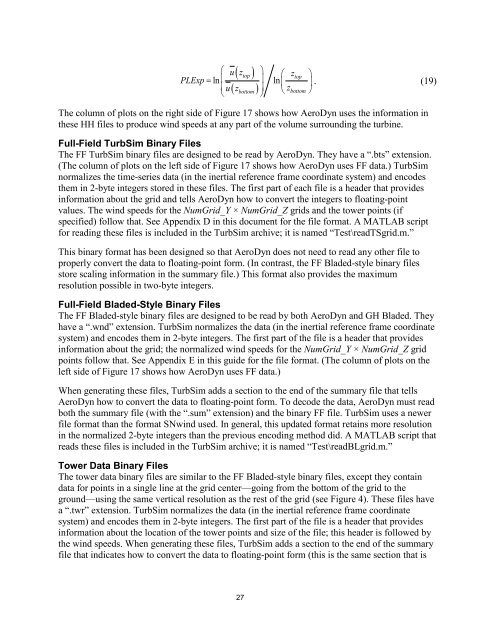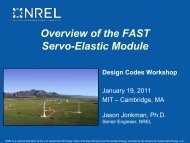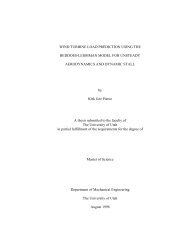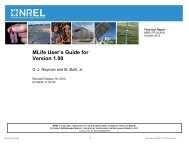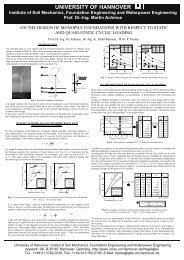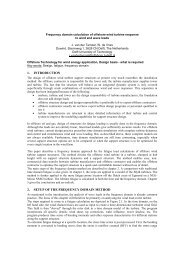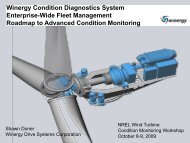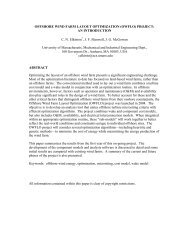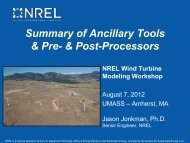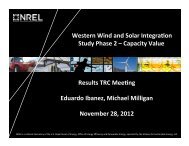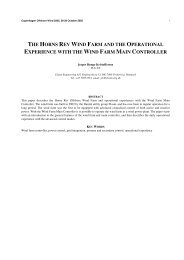TurbSim User's Guide: Version 1.06.00 - NREL
TurbSim User's Guide: Version 1.06.00 - NREL
TurbSim User's Guide: Version 1.06.00 - NREL
You also want an ePaper? Increase the reach of your titles
YUMPU automatically turns print PDFs into web optimized ePapers that Google loves.
( top )⎛ u z ⎞ ⎛ ztop⎞PLExp = ln ⎜ ⎟ ln ⎜ ⎟. (19)⎜u( zbottom) ⎟ ⎝ zbottom⎝ ⎠⎠The column of plots on the right side of Figure 17 shows how AeroDyn uses the information inthese HH files to produce wind speeds at any part of the volume surrounding the turbine.Full-Field <strong>TurbSim</strong> Binary FilesThe FF <strong>TurbSim</strong> binary files are designed to be read by AeroDyn. They have a “.bts” extension.(The column of plots on the left side of Figure 17 shows how AeroDyn uses FF data.) <strong>TurbSim</strong>normalizes the time-series data (in the inertial reference frame coordinate system) and encodesthem in 2-byte integers stored in these files. The first part of each file is a header that providesinformation about the grid and tells AeroDyn how to convert the integers to floating-pointvalues. The wind speeds for the NumGrid_Y × NumGrid_Z grids and the tower points (ifspecified) follow that. See Appendix D in this document for the file format. A MATLAB scriptfor reading these files is included in the <strong>TurbSim</strong> archive; it is named “Test\readTSgrid.m.”This binary format has been designed so that AeroDyn does not need to read any other file toproperly convert the data to floating-point form. (In contrast, the FF Bladed-style binary filesstore scaling information in the summary file.) This format also provides the maximumresolution possible in two-byte integers.Full-Field Bladed-Style Binary FilesThe FF Bladed-style binary files are designed to be read by both AeroDyn and GH Bladed. Theyhave a “.wnd” extension. <strong>TurbSim</strong> normalizes the data (in the inertial reference frame coordinatesystem) and encodes them in 2-byte integers. The first part of the file is a header that providesinformation about the grid; the normalized wind speeds for the NumGrid_Y × NumGrid_Z gridpoints follow that. See Appendix E in this guide for the file format. (The column of plots on theleft side of Figure 17 shows how AeroDyn uses FF data.)When generating these files, <strong>TurbSim</strong> adds a section to the end of the summary file that tellsAeroDyn how to convert the data to floating-point form. To decode the data, AeroDyn must readboth the summary file (with the “.sum” extension) and the binary FF file. <strong>TurbSim</strong> uses a newerfile format than the format SNwind used. In general, this updated format retains more resolutionin the normalized 2-byte integers than the previous encoding method did. A MATLAB script thatreads these files is included in the <strong>TurbSim</strong> archive; it is named “Test\readBLgrid.m.”Tower Data Binary FilesThe tower data binary files are similar to the FF Bladed-style binary files, except they containdata for points in a single line at the grid center—going from the bottom of the grid to theground—using the same vertical resolution as the rest of the grid (see Figure 4). These files havea “.twr” extension. <strong>TurbSim</strong> normalizes the data (in the inertial reference frame coordinatesystem) and encodes them in 2-byte integers. The first part of the file is a header that providesinformation about the location of the tower points and size of the file; this header is followed bythe wind speeds. When generating these files, <strong>TurbSim</strong> adds a section to the end of the summaryfile that indicates how to convert the data to floating-point form (this is the same section that is27


